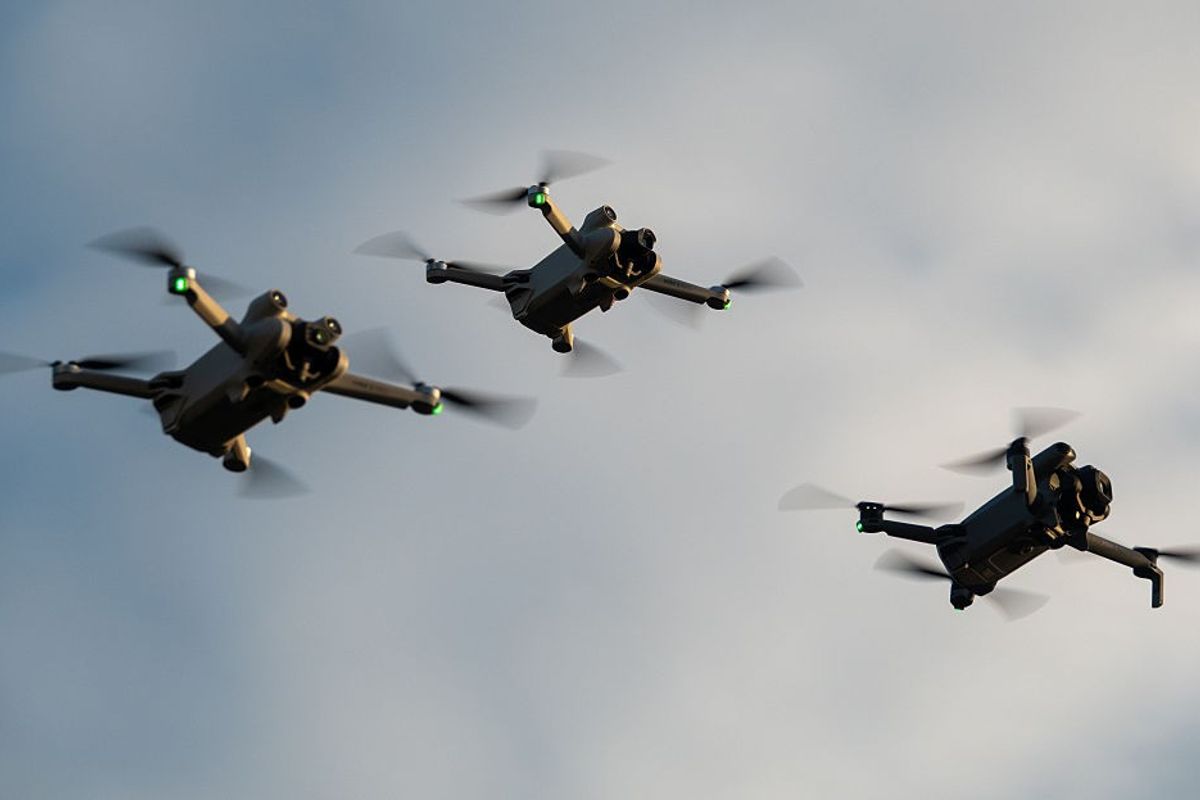OPINION / ANALYSIS — The world is speeding up. Adversaries such as China are seeking to remake global power structures and compete with the United States for global influence. A race toward technological advancement underpins the competition over economic power, public health, influence over potential allies, intelligence work, hybrid conflict, and even military strength. The competitor who demonstrates a technological advantage on these fronts has an edge in global influence and an advantage across the spectrum of conflict, with corresponding deterrent effect.
Seven critical technologies are likely to make a significant difference in the success of the United States and its allies across the spectrum of conflict over the next decade. The U.S. government should “sprint” on three critical technologies where current commercial developments are not fast enough or not tailored enough for U.S. government need: 1.) bioengineering technology; 2.) secure, redundant communications networks; and 3.) quantum technology. The U.S. government should “follow” in four other areas: 4.) space-based sensors; 5.) miniaturized, long-lasting batteries; 6.) robotics; and 7.) artificial intelligence/machine learning.
In the following three “sprint” areas, the U.S. government should give a high priority to nurturing private sector research, conducting in-house R&D for military-specific functions, and funding these areas as if the United States were in a conflict:
Secure and Redundant Communications. Today, setting up a communications capability in the field is challenging at best. According to a U.S. Army study, tent-based command posts require “hours of setup, including thousands of feet of copper wiring, which delays network availability and results in a dangerous lack of situational awareness for commanders ... Entering a dynamic tactical environment ‘blind’ puts warfighters at a significant disadvantage, which can lead to loss of life and mission failure.” Space has become a contested domain. Concern has grown around the vulnerability of undersea cables, and Huawei’s global expansion has called into question which information and communications technology (ICT) networks are secure.
The goal should be self-healing mesh networks, such that an adversary would need to take out several communications nodes to impinge on an ally’s ability to function. Creating secure, redundant communications will involve layers of technologies, and those layers will vary based on the situation. Redundancy will be a combination of satellite and ground-based capabilities, and truly effective communications systems will be secure and seamless across services.
Looking for a way to get ahead of the week in cyber and tech? Sign up for the Cyber Initiatives Group Sunday newsletter to quickly get up to speed on the biggest cyber and tech headlines and be ready for the week ahead. Sign up today.
Quantum Technology. Government investment will be necessary in a range of areas to win the race for useful quantum technology, including researching quantum networking and implementing quantum-resistant encryption standards across the government. DOD needs to signal government demand for quantum over the long run by contracting for small milestones or precursor equipment. A quantum sprint will require encouraging bright scientific minds to turn their sights on quantum advances. According to McKinsey, by 2025 less than 50 percent of quantum computing jobs will be filled.
Bioengineering. Much of the energy behind bioengineering is in the medical industry, which could serve a dual-use function with some military requirements. However, applications such as self-healing textiles, high-temperature compounds, and emergency field medicine are likely to get less attention without the U.S. government signaling strong demand. Research into defensive applications is essential and urgent. The U.S. government must assume that adversaries are exploring weapons applications for bioengineering and should devote extensive resources to creating both norms and effective defense. That will likely take the form of highly classified and restricted R&D, diplomatic efforts to describe the threat and the need for international rules, and collaboration with industry to ensure that potentially harmful applications are effectively controlled. Suddenly widespread AI tools could create new biological and chemical compounds, making the establishment of norms and rules for this combination of technologies urgent.
With the four “follow” technologies, the U.S. government can encourage industry down the current path and make minor changes to commercial-off-the-shelf (COTS) products to meet the government’s needs:
Space-Based Sensors. Industry has a robust capability for launch, as well as for building satellites, from CubeSats to sophisticated communications networks. The government can go along for that ride and encourage the creation of sensitive sensor packages and on-orbit processing of data. The government could hold competitions to signal demand, for example, for the most effective on-orbit deployment of AI/ML-enabled computing power to tip and cue off satellite images, or a sophisticated hide-and-seek competition where industry must use automation to find an object the U.S. military or intelligence community has hidden somewhere in the world. That competition could also find signals, such as a beacon, or a chemical signal, to encourage development of a variety of sensors.
High-Performance Batteries. The commercial sector has a huge financial incentive to create long-lasting and sustainable miniaturized batteries. From screens that fold to miniaturized medical devices, the demand for commercial battery solutions is rising.
Military demand will share some overlap, but high-end military requirements will be for more stable and heat-free solutions, particularly batteries that do not degrade when exposed to water or in extreme heat or cold. Military acquisition experts should look for the 80 percent solution and the 100 percent solution as two different requirements: COTS products will do 80 percent of the job providing power for military needs, but in a small percentage of use cases, such as stealthy special forces missions or underwater use, only the 100 percent solution will do. Those small-percentage use cases should be procured separately.
AI/ML. Development is robust in the commercial sector, and many companies are pursuing a dual-use strategy. DOD has a role to play in driving innovation in specific use cases and establishing high standards for integrity and security. Each agency should have a plan for AI/ML adoption, a person or group of people responsible for implementing that plan, and accountability mechanisms to agency leadership for managing the incorporation of AI/ML technology. The intelligence community can begin by updating Intelligence Community Directive 203 to begin to describe analytic standards for use of AI/ML. DOD and the intelligence community must find a middle ground between security of data and systems and allowing private entities access to U.S. government data for training AI/ML systems and testing government applications. Further, DOD and the intelligence community should have appeal mechanisms for decisions by a security officer, likely ending with the deputy secretary or deputy director of the agency in question.
Robotics. Modern industrial and collaborative robots are smaller, more agile, enhanced by cloud-based processing and AI/ML software, and designed to facilitate human-machine teaming. Generally, what the military needs will be readily transferable from COTS products, with additional requirements for off-road ruggedness. The kind of advancements the military needs can be encouraged by competitions for robots to accomplish tasks in harsh environments, with minimal fuel usage, and to act predictably when they lose connection, such as using a “home base” functionality. The U.S. government should explore collaboration with industry partners who have solved complex logistical problems with the help of robotics.
The Cipher Brief hosts expert-level briefings on national security issues for Subscriber+Members that help provide context around today’s national security issues and what they mean for business. Upgrade your status to Subscriber+ today.
Even the most revolutionary technologies are useless if the government cannot buy and incorporate them into practice. A critical self-evaluation of acquisition practices is necessary, in particular how to create a parallel pathway for software and other highly iterative technologies. The government’s acquisition processes are designed for procuring bespoke products on long time horizons—a structure that makes government contracts risky for small and medium-sized companies. As a result, the government finds itself simultaneously celebrating private sector innovation and struggling to take advantage of new technological advances. Still, the mission focus of the government means that where there is a will, there is a waiver. During a crisis, even the Pentagon finds ways to speed up processes and find quicker ways through the maze of restrictions. The Ukraine conflict has been a prime example of this mindset, from the rapid delivery of advanced systems and training to bolting HARMs missiles on a MiG-29. Conflicts of the future will require similar urgency, inventiveness, and “why not” thinking. The government needs a shift in the understanding of risk and a preemptive urgency that will accelerate the progress already underway.
Deterrence is impossible without a credible ability to respond to a threat, and that credibility will come from demonstrating that the United States can compete today and is committed to winning a fight in the future. The real risk comes from doing nothing. As one interviewee put it: “People don’t understand risk. By saying they won’t do risky projects, they are transferring risk to the warfighter. [A] Congress not willing to take risks . . . could endanger soldiers by giving them bad software and tech. We need a new way of thinking about this.”
Contracting officers having personal liability for contracts is also a huge obstacle to greater risk acceptance; DOD lawyers should find ways to guard against corruption that are less of a deterrent to taking calculated risks. In the longer term, a zero-based review of software acquisition should evaluate why each step in the process is necessary and brainstorm how to cut the number of steps by 75 percent.
Interviewees for this project unanimously agreed that creating a tech-savvy workforce would be necessary to implementing any of these technologies. The government should retrain a portion of the acquisition workforce—including the lawyers who oversee it—specifically on technology acquisition practices, emphasizing quick turnarounds and how to creatively work within existing regulations. Military services should create technology-focused career paths for uniformed personnel. Since many military recruits are from military families, Congress should create grant programs for schools on and around military bases that will create an elite-caliber science, technology, engineering, and medicine (STEM) curriculum, starting in elementary school and providing military technology apprenticeships in high school. The Congressional Research Service should significantly bolster its cadre of technologists, and Congress should undertake a briefing program for members and staff on its appropriations, armed services, and intelligence committees, along with the personal office staffs of those who serve on those committees.
The adversary also gets a vote, and Beijing and Moscow are surely eyeing U.S. technological prowess with concern. As CSIS’s Jim Lewis put it, “The Russians and Chinese worry about American space and anti-satellite attack, cyberattack, hypersonic strike, precision-guided munitions, electronic warfare, autonomous weapons and vehicles, and robots linked to AI. They worry that these technologies give the United States a strategic edge.” They need to stay concerned. In order to maintain a deterrent, the U.S. national security apparatus needs vision and humility — vision to see the capabilities needed to prevail in competition and humility to let industry partners provide solutions off the shelf that achieve most of the U.S. government’s needs. Where the requirements really must be bespoke and nonnegotiable, the partnership between industry and government will be able to create that game-changing technology.
The Cipher Brief is committed to publishing a range of perspectives on national security issues submitted by deeply experienced national security professionals.
Opinions expressed are those of the author and do not represent the views or opinions of The Cipher Brief.
Have a perspective to share based on your experience in the national security field? Send it to Editor@thecipherbrief.com for publication consideration.
Read more expert-driven national security insights, perspectives and analysis in The Cipher Brief because National Security is Everyone’s Business















